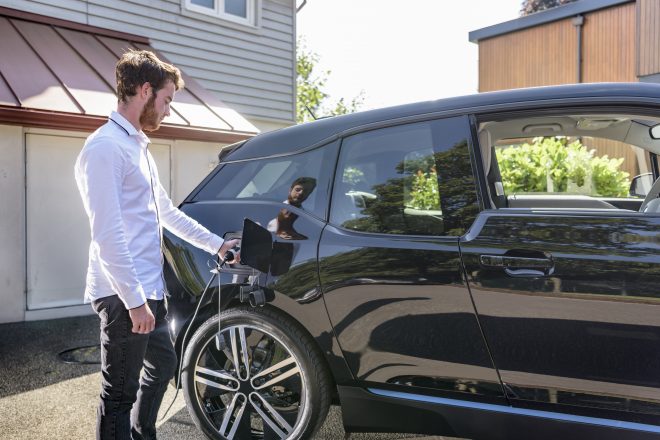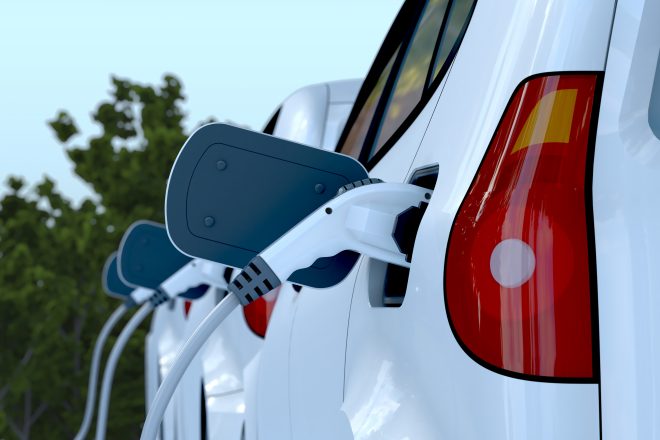Charging & Charge Time
X minutes reading time
There are several ways to charge your car. This can be done at home via a wall socket, at a home charging station, at a public charging station or at a fast charging station. This article will discuss the differences and give you some practical tips.

Charging your car at home
There are two options if you want to charge your car at home. You can charge from the wall socket or a private charging station.
Via the wall socket
Charging via wall socket takes the longest and is recommended only in emergencies. When doing this, make sure that you don’t just plug the cable into any socket but that it is a group with the proper fuses. When charging the car, do not use an extension cable, but only the appropriate charging cable with a charge protector (emergency charging cable), which – in some cases – is supplied with the car from the factory. You can charge your car at approximately 2.3 kW through the wall socket with a charge protector. This means you can charge 125 to 150 km in 12 hours.
Home Charging Point
Charging at home via a charging point requires an investment, but you can be sure that you are charging safely and at higher speeds than a regular socket. How fast your car charges at the home charge point depends on both the charge point and the car’s power and charger type. Assuming the average car (60 kW) and the average charging point (11 kW), the charging time is about 5 to 6 hours. Do you drive longer distances daily? Then this is the best option. Also financially. With a dynamic energy contract, you can charge at a time that is convenient for you. If you also combine this with solar panels on your house, you could even make money. You’ll also contribute to a better balancing of the energy grid.
Public or on-the-go charging
The Netherlands has tens of thousands of (semi-)public charging points and thousands of fast charging points. This is convenient because that way you can always charge somewhere. Always check your charge card provider’s app or website to see where you can charge with your card.
Tips:
●Always try to charge the car while parking. That way, you avoid unnecessary stops at fast chargers along the way.
●Public charging is cheaper than fast charging (except for the Tesla Supercharger network for Tesla drivers). And charging at home or work is (usually) cheaper than public charging.
●If you have trouble accepting your pass at a public charging station, call the emergency helpline number at the charging station for further assistance. Or try another charging station from another provider.
Fast charging stations
With fast charging stations, the charging time depends on the charging technology of both the car and the fast charger. You will find these speeds in kW on the quick charger. If you choose too slow a fast charger, you’ll have to charge for too long; if you choose too fast a fast charger, you keep it unnecessarily occupied for other electric cars that can handle higher speeds. So make sure you know how fast your car can fast-charge. Then you will always be at the right fast charger, and you can quickly continue your journey.
Electric cars charge from 20% to 80% in 30 minutes at fast chargers on average. The first and last 20% are usually slower, but in practice, these are usually not charged at a fast charger because you will already have charged enough to continue the journey.
Charging time calculation model
To calculate how much time it takes to recharge your battery, use the calculation below.
Battery capacity (e.g., 74 kW) divided by charging capacity (e.g., 11 kW) = Charging time (6.73h > 6 hours and 44 minutes).
Charging an electric car with an average battery capacity (60 kWh) to 80% full takes:
- 21 hours via the socket (2.3 kW)
- 4.5 to 13 hours via a charging station at home (11 – 3.7 kW)
- 2 to 4.5 hours via a public charging station (22 – 11 kW)
- 12 to 58 minutes via a fast charger (250 – 50 kW)
Travelling with an electric car
Fearing a dead battery on the road or traffic jams at fast chargers, many EV drivers prefer to leave their electric cars behind when they take a long trip. This is a shame and unnecessary because, with the right preparation, you can also tour Europe just fine with your electric car.
Be sure to make an itinerary in advance that takes into account your car’s battery life and possible factors that affect it, such as hilly landscapes or the use of air conditioning. Use this planner to determine your route from charging point to charging point, or read this article with a list of 7 popular apps that will help you find a charging station and give you other useful features.
You’ve read what types of charging stations there are and what to consider when you want to charge. Charging times and rates vary by location, but with proper preparation, you know exactly what to expect and what the possibilities are. Even when you go on vacation.


